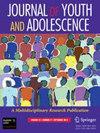Effects of a Whole-School Prevention Program Targeting Mental Health and Nonsuicidal Self-Injury in Swedish Adolescents: A Cluster-Randomized Experimental Study with Longitudinal Follow-Up.
IF 3.6
1区 心理学
Q1 PSYCHOLOGY, DEVELOPMENTAL
引用次数: 0
Abstract
Rising rates of mental health problems and nonsuicidal self-injury (NSSI) among adolescents highlight the need for preventive interventions and the lack of evidence regarding such measures. To date, few studies have investigated school-based prevention programs targeting NSSI. In this study, a whole-school preventive intervention was carried out at Swedish lower secondary schools and evaluated in a cluster-randomized controlled trial. The whole-school intervention included classroom-based modules focusing on mental health and NSSI directed at students, psychoeducational webinars on NSSI directed at parents and teachers, and a two-day workshop on NSSI and suicidality for school health staff. Data were collected from students (N = 183, age M = 14.17, SD = 0.55, 58% female) at baseline and three- and six-month post-intervention follow-ups. Analyses revealed a significant decrease in three-month NSSI frequency and a significant difference in mental health-related stigma awareness in the intervention group compared to controls. Regarding other outcomes (NSSI onset, attitudes toward help-seeking, perceived social support, health-related quality of life, emotion regulation and self-criticism), no significant effects were found. Effects moderated by gender and history of NSSI were found, underscoring that the outcomes of universal prevention are not always uniformly distributed. Main conclusions were that whole-school prevention can be effective in reducing NSSI frequency as well as affecting the awareness of mental health-related stigma.针对瑞典青少年心理健康和非自杀性自伤的全校预防项目的效果:纵向随访的集群随机实验研究
青少年中心理健康问题和非自杀式自伤(NSSI)的发生率不断上升,这突出表明需要采取预防性干预措施,但缺乏有关此类措施的证据。迄今为止,很少有研究调查了针对自伤的学校预防计划。在这项研究中,在瑞典初中进行了全校预防性干预,并在一项集群随机对照试验中进行了评估。全校干预包括针对学生的以课堂为基础的以心理健康和自伤为重点的模块,针对家长和教师的关于自伤的心理教育网络研讨会,以及为学校卫生人员举办的为期两天的关于自伤和自杀的讲习班。数据收集自学生(N = 183,年龄M = 14.17, SD = 0.55, 58%为女性)在基线和干预后3个月和6个月的随访。分析显示,与对照组相比,干预组三个月自伤频率显著降低,心理健康相关的耻辱意识也有显著差异。至于其他结果(自伤发作、求助态度、感知社会支持、健康相关生活质量、情绪调节和自我批评),未发现显著影响。结果发现,受性别和自伤史的影响,普遍预防的结果并不总是均匀分布的。主要结论是,全校预防可以有效降低自伤发生率,并影响对心理健康相关污名的认识。
本文章由计算机程序翻译,如有差异,请以英文原文为准。
求助全文
约1分钟内获得全文
求助全文
来源期刊

Journal of Youth and Adolescence
PSYCHOLOGY, DEVELOPMENTAL-
CiteScore
8.20
自引率
6.10%
发文量
155
期刊介绍:
Journal of Youth and Adolescence provides a single, high-level medium of communication for psychologists, psychiatrists, biologists, criminologists, educators, and researchers in many other allied disciplines who address the subject of youth and adolescence. The journal publishes quantitative analyses, theoretical papers, and comprehensive review articles. The journal especially welcomes empirically rigorous papers that take policy implications seriously. Research need not have been designed to address policy needs, but manuscripts must address implications for the manner society formally (e.g., through laws, policies or regulations) or informally (e.g., through parents, peers, and social institutions) responds to the period of youth and adolescence.
 求助内容:
求助内容: 应助结果提醒方式:
应助结果提醒方式:


